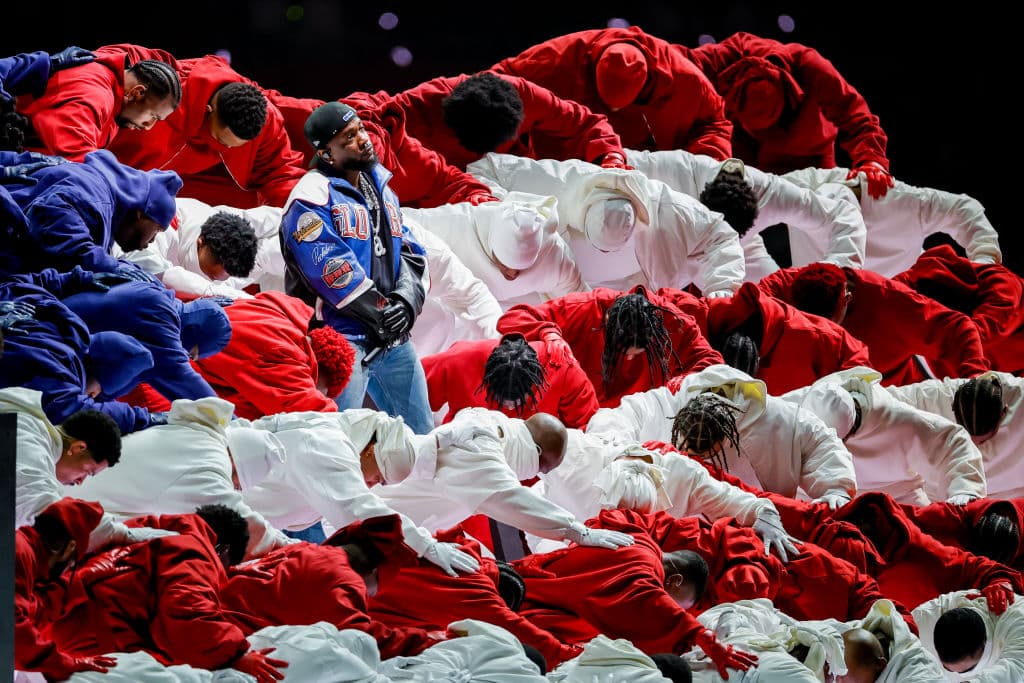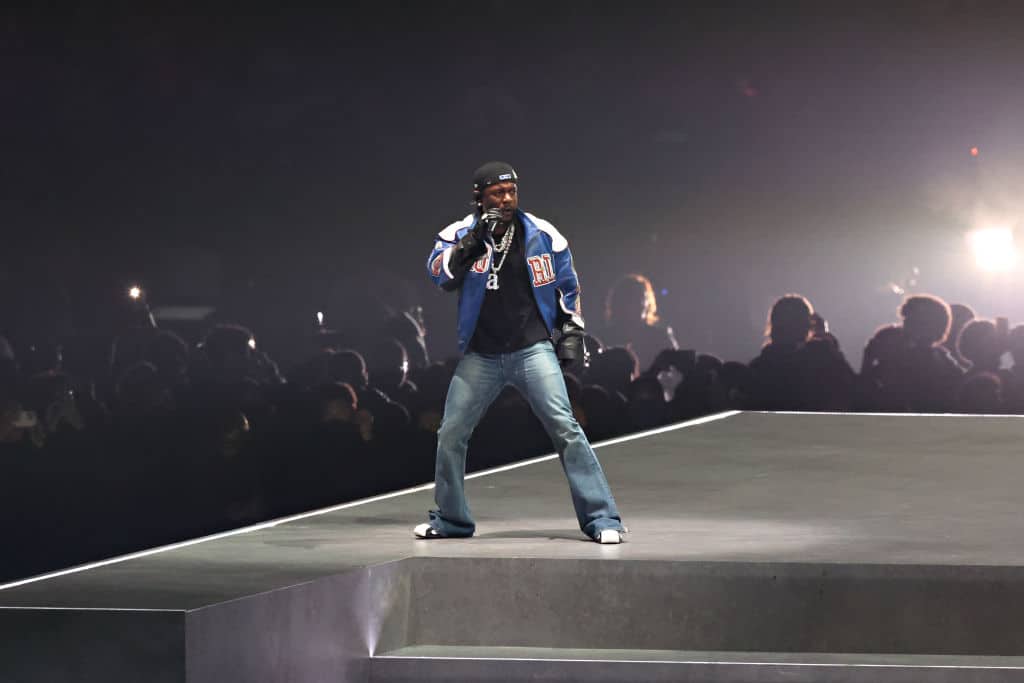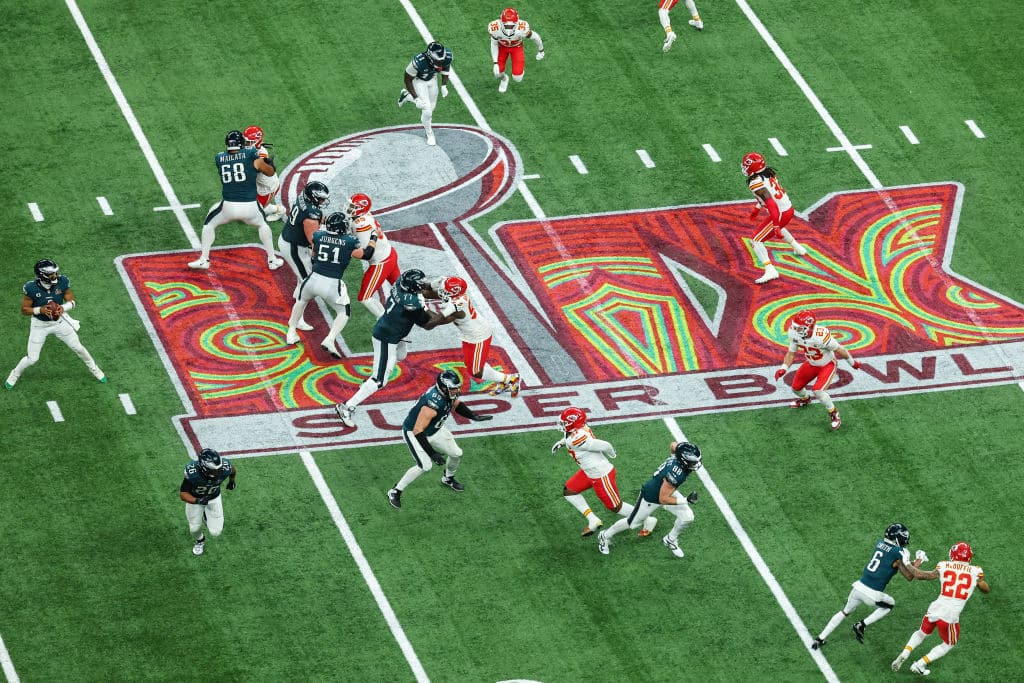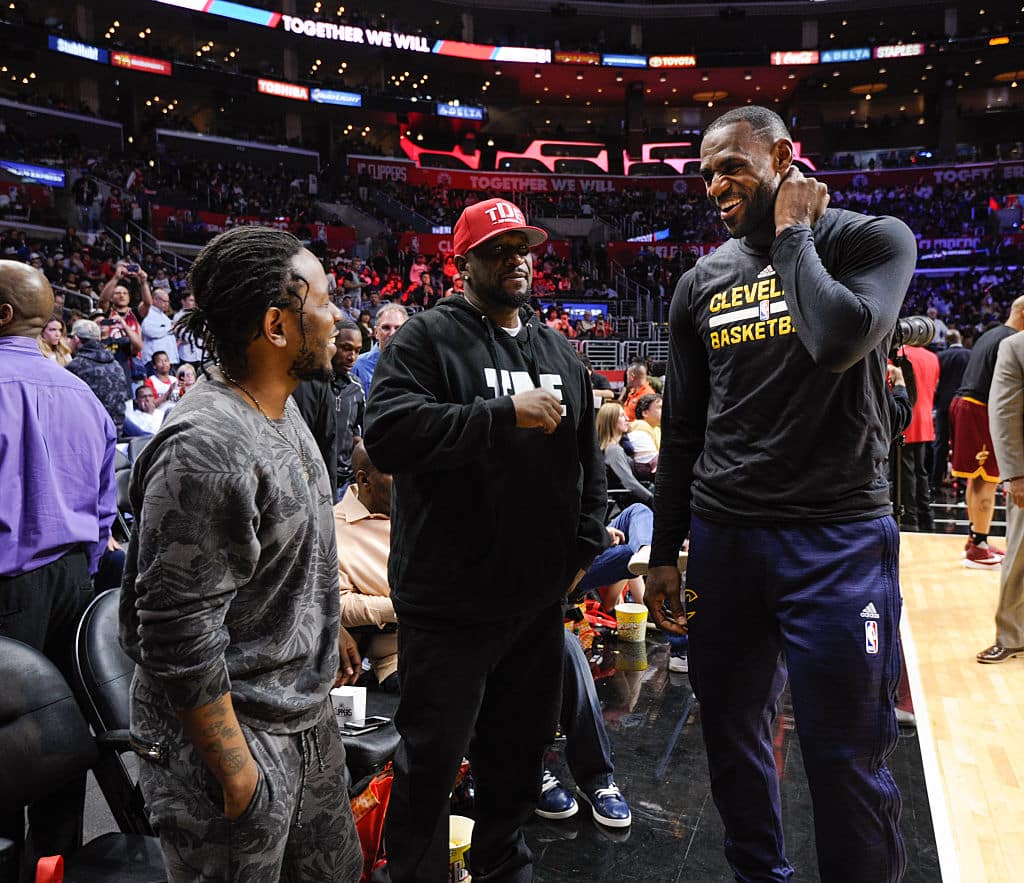kendrick lamar
Page: 6
HipHopWired Featured Video
Source: Icon Sportswire / Getty
Yes, you read that right.
Kendrick Lamar’s Super Bowl LIX halftime show was hands down one of the Blackest moments of 2025. In just 13 minutes, he flipped Gil Scott-Heron’s The Revolution Will Not Be Televised, seemingly took aim at Trump, and delivered a powerful American story—all while throwing lyrical haymakers at Drake.
Source: Icon Sportswire / Getty
The Black Pride and Political Messaging
Let’s start with the deeper themes. The entire performance felt like a message to Drake, but it also paid homage to Spike Lee’s Bamboozled. Samuel L. Jackson, playing the role of Uncle Sam, wasn’t just a jab at Drake and the industry—it was also a shot at the executives and critics who wanted Kendrick to dial down his relentless lyrical assault on Drizzy. It even took aim at those who dismissed Lamar as doing Civil Rights Rap—as if calling out injustice is a bad thing.
Jackson’s narration made that clear when he introduced Lamar saying, “It’s your Uncle…Sam, and this is the great American game.” The line exposed how America polices Black artistic expression, punctuated by Jackson’s follow-up: “Too ghetto”—right before his mic was cut.
The symbolism didn’t stop there. The American flag served as a double entendre: a reminder that the country was built on the backs of enslaved Black people, but also a critique of how racism continues to divide. Lamar’s dancers even wore outfits reminiscent of The Mau Maus, the militant culture purists in the film Bamboozled, underscoring his message about protecting Black culture from exploitation.
Then came the “Not Like Us” moment. Looking his dancers dead in the eye, Lamar declared: “This is bigger than the music.” Highlighting the phrase—40 acres and a mule—refers to the unfulfilled reparations promise from 1865, a theme Lamar has touched on before in To Pimp a Butterfly. In the song “Wesley’s Theory,” he rapped about the illusion of prosperity for Black Americans: “What, you want you a house or a car? / Forty acres and a mule, a piano, a guitar?” By bringing it to the Super Bowl stage, he made it clear: the fight for equity isn’t over—especially in his home state of California, where reparations debates are ongoing—hence the sign in the crowd saying “wrong way” because he was speaking up in a sanitized forum.
WARNING WRONG WAY! Nothing but respect for Kendrick 🇺🇸 pic.twitter.com/hnxCXlIr8C
— ECP408 (@ecp408) February 10, 2025
https://platform.twitter.com/widgets.js
The Direct Shots at Drake
Now Let’s discuss the direct jabs at Drake.
During the performance, Lamar teased the crowd with the possibility of performing his Drake diss and L.A. anthem, “Not Like Us.”
“I want to play their favorite song, but you know they love to sue,” he quipped, referencing Drake’s defamation lawsuit. As the beat dropped, Lamar flashed a sly smile and rapped, “Say, Drake, I hear you like ‘em young,” before letting the audience complete the lawsuit-inspiring line—”certified pedophile.” The litigious remark comes after Drake took his issues with “Not Like Us” to court, in January filing a federal lawsuit against Universal Music Group over the diss track that accuses him of being a pedophile, allegedly.
Midway through, Lamar locked eyes with the camera and dropped another bombshell: “They tried to rig the game, but you can’t fake influence.” The line was widely seen as a response to Drake’s lawsuit against Universal Music Group, which accuses the label of helping spread the allegations fueling “Not Like Us.” With that one line, Lamar dismissed both the lawsuit and any industry attempts to undermine his influence.
The Subtle (and Not-So-Subtle) Jabs
Despite its deep cultural messaging, Lamar’s performance was full of layered shots, including the set designed as a giant PlayStation controller—pointing to Sony, the parent company of Drake’s label, OVO as he was literally controlling the narrative while fueling conspiracy theories about hidden messages.
And then there was Serena Williams. The tennis legend hit the C-walk on the X button to “Not Like Us”—a callback to the backlash she faced for using the dance to celebrate her Olympic gold medal win in 2012. This wasn’t just shade at Drake, but also a broader message about respectability politics and Black joy being policed.
Lamar closed with an electrifying performance of “tv off” with DJ Mustard, bringing the show full circle. The track’s message? Stop getting distracted—wake up to reality. And, of course, it doubled as a parting shot at Drake and J. Cole’s “First Person Shooter,” proving once again that Lamar plays the biggest game of all.
The Bigger Picture
Before the big night, Lamar told Apple Music that his performance would be culturally significant and an evolution of everything he’s done before. He wasn’t lying. The internet is still dissecting every line, every symbol, every move. But as Jay-Z said back in 2001, “You fools don’t listen to music, you just skim through it.”
Kendrick wasn’t just putting on a show. He was making history.
—
*Respectfully.
This year’s Super Bowl has made television history, with the broadcast setting a ratings record for the second year in a row.
According to FoxSports, an average of 126 million viewers tuned in to watch their broadcast on Sunday (Feb. 9), which saw the Philadelphia Eagles emerge victorious over the Kansas City Chiefs with a final score of 40 to 22. According to the network, those figures measure viewers across Fox, Fox Deportes, Tubi, Telemundo and NFL digital properties.
That number is a 2% increase on the 123.7 million viewers who watched last year’s event, which outshone any audience previously recorded by Nielsen. Fox also noted that their peak audience of 135.7 million viewers occurred around the game’s second quarter, between 8:00-8:15pm ET.
Explore
Explore
See latest videos, charts and news
See latest videos, charts and news
Though the evening’s big takeaway was undoubtedly related to the game itself, a sizable portion of the Super Bowl’s viewership likely came thanks to the halftime show, which featured Kendrick Lamar in the spotlight.
Trending on Billboard
Much of the discourse relating to Lamar’s appearance revolved around the potential content of his performance – specifically whether he would perform his Drake diss track “Not Like Us”.
Having inspired a defamation lawsuit from its subject matter against Lamar (and Drake’s) record label, Universal Music Group in January, and having taken home five Grammys (including Record of the Year and Song of the Year) just a week earlier, Lamar ensured that the song received pride of place in his already-iconic set. Samuel L. Jackson, SZA, and Serena Williams also joined Lamar onstage for the performance at New Orleans’ Caesars Superdome.
Currently, specific break-out numbers for the halftime show have not been made available, though it would likely be in contention for the title of the most-watched halftime show in history. According to The Hollywood Reporter, that honor belongs to the 1993 Super Bowl, which saw Michael Jackson change the face of halftime entertainment, bringing in 133 million viewers for his appearance.
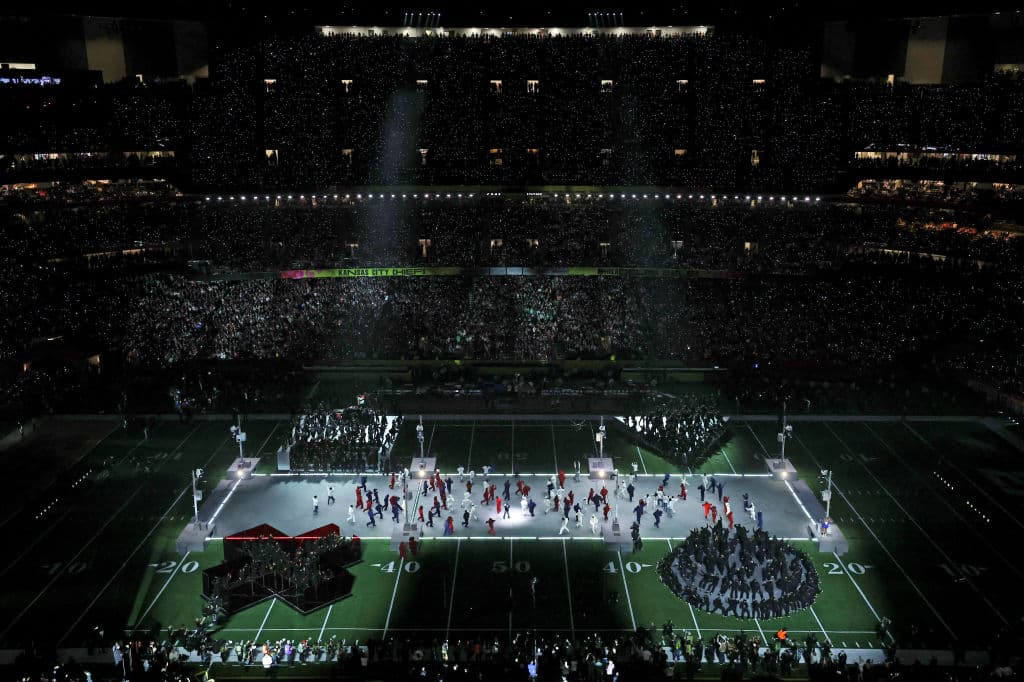
HipHopWired Featured Video
CLOSE
Source: Patrick Smith / Getty / Kendrick Lamar / PlayStation
Kendrick Lamar’s Super Bowl LIX halftime performance had more easter eggs than a Marvel Studios film. One in particular caught the attention of gamers who were tuned in.
You were absolutely correct if you thought Kendrick Lamar’s performance had a video gamey-feel. Super Bowl LIX halftime show art director Shelley Rodgers confirmed to Wired that Lamar uses PlayStation imagery, mainly the icons on the PlayStation controller.
In the interview, Rodgers revealed that K.Dot devised the video game-themed performance, adding that “each performance space was shaped like a button on a PlayStation-style controller, a performance intended to portray Lamar’s life as a video game.”
No one knows why Lamar chose PlayStation or decided to go that route while he bullied Drake again, but the art director did have some suggestions.
“I think the was symbolic, his way to reach young people,” Rodgers told Wired. “A lot of it is showing his journey, [showing him] traveling through the American dream.”
Creative Director Mike Carson added more insight, adding that Lamar and his production company, pgLang, are “really into keeping things clean and minimal.”
“We went with a monochromatic concrete look and allowed the video game motif to come alive through dialogue, lighting, choreography, and music.”
There is no word on whether PlayStation knew about Lamar’s vision, but if they did, do you think Drake would also be BIG MAD at the video company for being involved, or nah?
Fans Loved The PlayStation Inclusion
Fans also had plenty to say about the moment. “Kendrick Lamar brought out the PlayStation symbols and said,’ Game Over,’” one user on X, formerly Twitter, wrote following the performance.
Another user added, “Serena Williams, Samuel Jackson, PlayStation references, the GNX, the whole stadium yelling “AMINORR” ugh the dancers in red, white & blue, SZA?! Thank you Kendrick. The revolution will be televised.”
Kendrick Lamar did that! Debate your auntie.
You can see more reactions in the gallery below.
4. Still need an answer
6. So cool
HipHopWired Featured Video
CLOSE
Lil Wayne became a trending topic on social media in the wake of Kendrick Lamar’s grand Super Bowl LIX halftime show performance in New Orleans. Lil Wayne saw his name trending on X just mere moments after Kendrick Lamar concluded his set, with fans wondering how he would’ve fared in his hometown.
Much has been made of Lil Wayne’s public expressions of disappointment for not being selected as the chief act for the Super Bowl LIX halftime set considering its location. Naturally, the expectation that a hometown act should grace the world’s biggest stage makes sense and, to the planning committee’s credit, the inclusion of Grammy Award-winning native son Jon Batiste and his rendition of the National Anthem satisfied some of those concerns.
Still, Weezy F. Baby believed that the halftime show should have been his moment, expressing hurt for being passed over. That said, Kendrick Lamar’s Apple Music Super Bowl Halftime Show set was full of dazzling imagery, choreography, and surprises such as Samuel L. Jackson playing a very tongue-in-cheek version of Uncle Sam with some veiled messages as the state of the nation. Also, Serena Williams showed up and hit her steps during Lamar’s “Not Like Us” performance, and SZA provided some support by way of “Luther” and the crowd-pleasing “All The Stars.”
In an alarming bit of backlash, some fans are criticizing Lamar’s performance, with one X user calling the performance “Black Panther Raps” and other digs. Some other fans thought that Wayne’s big hits would’ve played well at the Caesars Superdome while plenty of others didn’t believe he would’ve had what it took to deliver.
On X, folks are taking shots at Lil Wayne and dressing down the Young Money honcho by speculating that he may not have measured up to what Lamar delivered. Weezy’s homeboy Skip Bayless, however, defended his friend on X. With the show in the rearview, there is no way to know how well Wayne would’ve done but fans on X have their strong opinions out front and center.
Check out the reactions below.
—
Photo: Getty
HipHopWired Featured Video
CLOSE
Source: Patrick Smith / Getty
Super Bowl LIX was not only about the game, but also about the star power that filled the stands with some of the biggest names in entertainment. Celebrities like Jay-Z, Summer Walker, Ice Spice, Doechii, and many more made their mark at the event, bringing their drip and undeniable presence to the spotlight. As the Philadelphia Eagles triumphed with a commanding 40-22 victory over the Kansas City Chiefs, the energy wasn’t just coming from the field. The celebrity crowd added to the electric atmosphere, offering their support and soaking in the excitement of one of the world’s biggest sporting events.
Rappers Glorilla and Megan Thee Stallion were among the notable attendees, but their presence came with a bit of drama (well, atleast for Glo). The two had made a high-stakes bet on the game, with Big Glo putting down $128,000 on the Chiefs, while Megan backed the Eagles. Unfortunately for Glorilla, her bet didn’t pay off, and she left the stadium upset after the Eagles’ victory, making it a memorable moment off the field.
Beyond the excitement of the game, the event showcased the fusion of sports, music, and fashion. some of our favorite artists brought out all their signature styles, further solidifying the Super Bowl as a gathering not just for football fans but for those with a passion for entertainment and pop culture. Super Bowl LIX wasn’t just about the Eagles’ victory—it was a night where the worlds of music, fashion, and celebrity collided, leaving fans with unforgettable memories both on and off the field.
Father John Misty had a timely reaction to Kendrick Lamar’s Super Bowl Halftime Show performance on Feb. 9, which happened to coincide with the 10th anniversary of his second studio album I Love You, Honeybear.
Explore
See latest videos, charts and news
See latest videos, charts and news
The singer-songwriter, born Josh Tillman, took to X (formerly Twitter) on Feb. 9 to acknowledge the moment with a dry, understated jab. “Had to do his super bowl performance today of all days nice,” he wrote, referencing Lamar’s blockbuster set.
Trending on Billboard
The timing of Lamar’s high-profile performance was particularly on brand for Tillman, who has joked about his albums frequently dropping in the same years as Lamar’s.
In response to a fan pointing out the pattern, he previously noted, “It’s okay only other times it’s happened was 2012, 2015, 2017 and 2022.”
The playful back-and-forth between the two artists resurfaced in November when Lamar surprise-released GNX on the same day as Tillman’s Mahashmashana. Misty responded by posting a mock “diss track” titled “God’s Trash” on Instagram, featuring parody cover art inspired by Lamar’s recent diss records aimed at Drake.
The I Love You, Honeybear anniversary wasn’t just marked by social media quips. The album, originally released in 2015, was praised upon arrival for its satirical, deeply personal take on love and existentialism. It debuted at No. 17 on the Billboard 200 and became a defining release of the indie-folk singer’s career. To celebrate its milestone, Misty recently announced a remastered reissue, set for release on Feb. 14.
Meanwhile, Lamar’s Super Bowl set was widely discussed for its inclusion of his Grammy Award-winning “Not Like Us,” the Mustard-produced track that became a viral cultural moment in 2024.
His halftime performance also made headlines when Serena Williams joined him onstage, dancing to the song’s most cutting lyrics—fueling further speculation about the ongoing tensions between Lamar and Drake, who is currently in Australia for his Anita Max Win Tour.
Misty and Lamar both remain booked and busy this year. The former Fleet Foxes drummer will hit the road for a UK and Ireland tour in June and August, making stops in Liverpool, Nottingham, Leeds, Glasgow, and Dublin. Lamar, on the other hand, is gearing up for a North American tour with SZA, set to take place this spring.
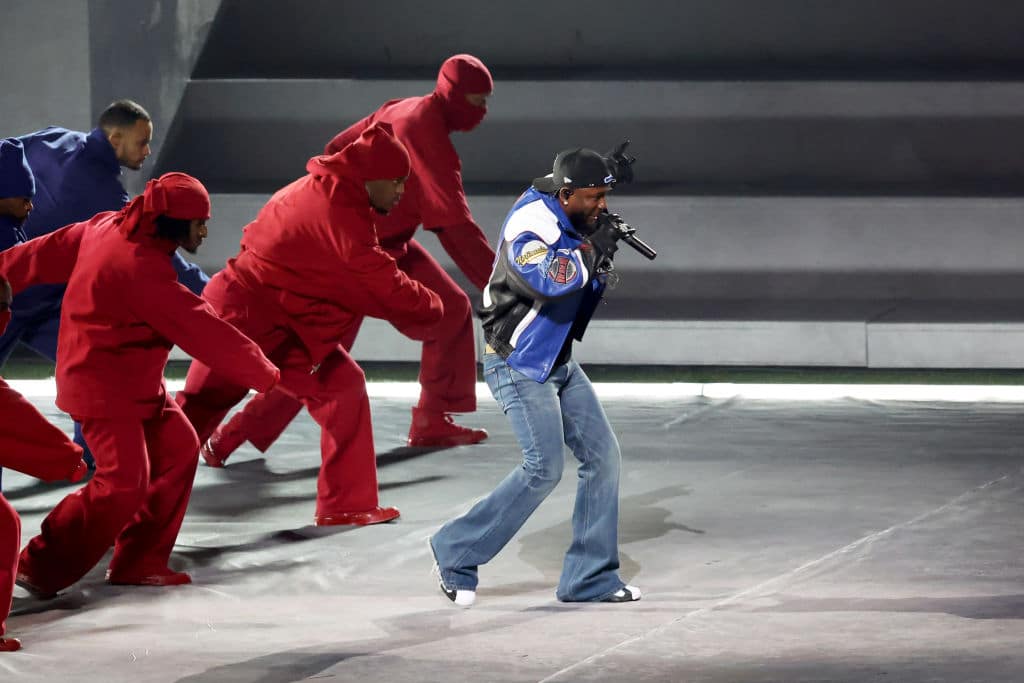
HipHopWired Featured Video
CLOSE
Source: Cindy Ord / Getty
Did Kendrick Lamar’s show live up to the hype?
There was already plenty of will he or won’t he when it came to performing his Grammy Award-winning, Drake demoralizing “Not Like Us” diss song. Well of course he did, but more on that later.
The Apple Music Super Bowl Halftime Show (that’s the official name) opened with an intro from actor Samuel L. Jackson dressed like a no-joke and woke patriot, and Kendrick Lamar rapping on the hood of a vintage whip auto, then kicking off with a rousing rendition of “squabble up” with a lot of dancers.
“Mr. Lamar do you really know how to play the game?” asked Jackson. K. Dot then proceeded to roll through a bunch of his newer-ish hits like “HUMBLE,” with the dancers creating great, US flag-like visuals, along with “DNA” and “Peekaboo.”
“I want to perform their favorite song, but you know they love to sue” – Kendrick Lamar pic.twitter.com/x1Ke3W3NLr
— philip lewis (@Phil_Lewis_) February 10, 2025
https://platform.twitter.com/widgets.js
Lamar then teased “Not Like Us,” with Jackson saying to exercise caution, but first, he brought out special guest SZA to perform “Luther” from GNX and “All The Stars.”
KENDRICK DID IT AND BROUGHT SERENA OUT TOOOOOOOOO LMAO #SuperBowl pic.twitter.com/RBxAvXcesc
— Qondi (@QondiNtini) February 10, 2025
https://platform.twitter.com/widgets.js
With a final warning from Jackson, K. Dot kicked off the DJ Mustard portion of the show, performing “Not Like Us,” with an entire stadium roaring “A Minor…” in unison before shifting into “tv off.” Oh yeah, that was Serena Williams on stage crip walking. And yes, he looked right into the camera when he uttered, “Say, Drake…”
“Say Drake, I hear you like ‘em young”
Why Kendrick look at the camera like 😭 pic.twitter.com/IDCt6sY5LZ
— Ms. Andry Noir, PhD (@keatingssixth) February 10, 2025
https://platform.twitter.com/widgets.js
There were a lot of joints Lamar left in the tuck such as “Alright,” “Swimming Pools,” and “Backstreet Freestyle” to name a few. But hey, time was limited. Speaking of, sort of, how many people just tuned in for the K. Dot concert with no care at all for the game? Asking for a friend.
Check out some of the more powerful reactions to Kendrick Lamar’s halftime show in the gallery.
—
Photo: Getty
All products and services featured are independently chosen by editors. However, Billboard may receive a commission on orders placed through its retail links, and the retailer may receive certain auditable data for accounting purposes.
With all eyes on New Orleans for the Big Game, with the Kansas City Chiefs batting against the Philadelphia Eagles, Grammy-winning rapper Kendrick Lamar is set to headline the Apple Music Super Bowl LIX Halftime Show on Sunday, Feb. 9.
Explore
Explore
See latest videos, charts and news
See latest videos, charts and news
Keep reading for a breakdown of ways to watch Super Bowl 2025 Halftime Show live from the Caesars Superdome.
And Kendrick Lamar with special guest SZA are not the only music act performing during Super Bowl LIX. Ledisi opens the Super Bowl with a performance of “Lift Every Voice and Sing,” while Trombone Shorty and Lauren Daigle sing “America the Beautiful.” Ahead of kickoff, Jon Batiste performs the U.S. National Anthem.
Trending on Billboard
When Does Super Bowl Halftime Show Start?
The Super Bowl LIX Halftime Show broadcasts live, with a start time around 8-8:15 p.m. ET/5-5:15 p.m. PT. The halftime show airs on Fox.
Where to Watch Super Bowl Halftime Show for Free
For cord-cutters, there are a few ways to watch Super Bowl LIX Halftime Show — especially if you want to watch for free. DirecTV Stream has a five-day free trial, while other streaming services — such as Fubo and Hulu + Live TV — also offer a free trial so you can watch Fox for free.
Keep reading for more details on how to watch the Super Bowl Halftime Show with DirecTV Stream and Hulu + Live TV.
How to Watch Super Bowl Halftime Show with DirecTV Stream
A subscription to DirecTV Stream’s “MySports” — which comes with Fox for Super Bowl LIX Halftime Show — gets you access to live TV, local and cable channels, starting at $49.99 per month for the first three months of service and $69.99 per month after that. The service’s new “MySports” package even offers a five-day free trial to watch for free if you sign up now.
You can watch local networks such as NBC, ABC, CBS and Fox, while you can also watch many of the best sports networks, including ESPN, FS1, CNBC, NBA TV, NHL Network, Big Ten Network, TNT Sports, The Golf Channel and many others.
How to Watch Super Bowl Halftime Show with Hulu + Live TV
The Super Bowl LIX Halftime Show with Kendrick Lamar on Fox is available to watch with Hulu + Live TV too. Prices for the cable alternative start at $82.99 per month, while each plan comes with Hulu, Disney+ and ESPN+ at no additional cost.
Hulu + Live TV might be best for those who want all of these streaming services together in one bundle. It also features many other networks, including ABC, Hallmark Channel, BET, CMT, Disney Channel, NBC, Fox Sports and more.
How to Watch Super Bowl Halftime Show with Fubo
To watch Super Bowl LIX Halftime Show on Fox, Fubo starts at $59.99 for the first month, $84.99 per month afterwards (the streamer’s current deal) with more than 210 channels — including local and cable — that are streamable on smart TVs, smartphones, tablets and on web browsers.
The service even gets you live access to local broadcast networks including NBC, CBS and ABC, while it also has dozens of cable networks, such as ESPN, Bravo, CMT, ID, TV Land, VH1, TLC, E!, FS1, MTV, FX, Ion, OWN, Paramount Network and much more.
Additionally, the Super Bowl LIX Halftime Show livestreams on Tubi.
How to Buy Super Bowl Halftime Show Tickets Online
Want to attend the Super Bowl Halftime Show? There are still last-minute tickets available via Vivid Seats (get $20 off purchases of $200 and over with code BB2024), SeatGeek (your first purchases can get $10 off ticket order $250 and with code BILLBOARD10), StubHub and GameTime (score $20 off ticket orders of $150 and over with code SAVE20). Prices vary depending on the city and seats available.
Moreover, you can save $150 off when you spend $500 with promo code BILLBOARD150, or $300 off when you spend $1,000 with promo code BILLBOARD300 at TicketNetwork.com.
Starting at 8-8:15 p.m. ET/5-5:15 p.m. PT, Apple Music Super Bowl LIX Halftime Show broadcasts on Fox. It’s also available to livestream on DirecTV Stream for free today.
Want more? For more product recommendations, check out our roundups of the best Xbox deals, studio headphones and Nintendo Switch accessories.
HipHopWired Featured Video
Source: Noel Vasquez / Getty / LeBron James
LeBron James seemingly had the perfect response to Drake following the rapper’s light jab at him during his first show on his Australian tour.
On Wednesday, LeBron James took to Instagram to express his excitement for Kendrick Lamar’s upcoming Super Bowl Halftime performance.
James shared a clip of an old K.Dot performance that was part of Dr. Dre’s epic medley during 2022’s star-studded Super Bowl Halftime show performance.
“He gone kill that [poo emoji]!!!! Can’t wait *Bart Scott voice,” Luka Doncic’s new running mate said in his Instagram Stories post.
Usually, this wouldn’t mean anything, but now it’s part of the ongoing battle between Drizzy and Lamar. Drizzy is still licking his wounds after “Not Like Us” has declared that anyone who rocked with Lamar and bopped to the Grammy-winning diss record is an enemy, including those he once considered friends like James.
Drake Has Been Taking Numerous Shots At LeBron James
Drake has been taking shots at LeBron James. During the opening night of this Anita Max Win Tour, the Six God changed the lyrics of his song “Nonstop.” In the original lyrics, Drake raps, “How did I go from 6 to 23 like I’m LeBron?”
During his performance on the Anita Max Tour, he switched the lyrics to criticize Bron, rapping, “How I go from 6 to 23 but not LeBron, man?”
This was not the only time Drizzy expressed his distaste for James. In his song “Fighting Irish Freestyle,” the Canadian Hip-Hop star seemingly criticized the Los Angeles Lakers superstar and DeMar DeRozan for attending Lamar’s epic Pop Out concert.
Fighting Irish is a nod to LBJ’s high school basketball team.
“The world fell in love with the gimmicks, even my brothers got tickets / Seemed like they loved every minute / Just know this shit is personal to us, and it wasn’t just business.”
James tried to show no love lost on his end, rocking a pair of The Boy’s Nike Air Force One sneakers with “Love you forever” etched on them, adding the infinity emoji to the post.
Meanwhile, Drake is still big mad and recently rocked a bullet hole-filled hoodie to signify all the shots he took and that he’s still here despite the “Not Like Us” kill shot.
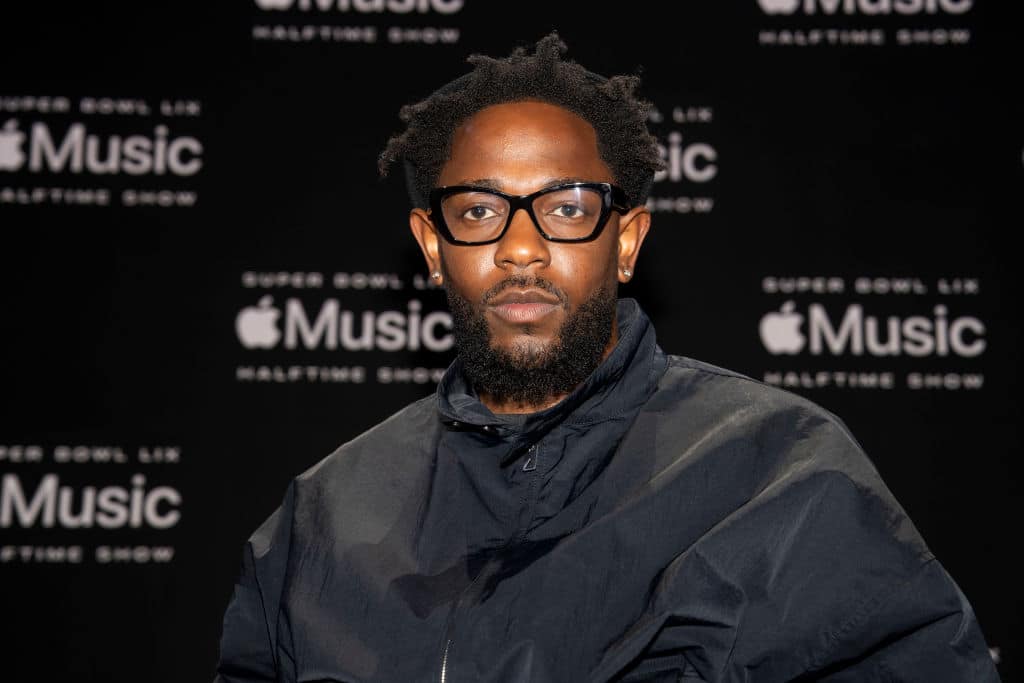
HipHopWired Featured Video
Kendrick Lamar, fresh from hauling in five trophies at the 67th Annual Grammy Awards, with his scathing Drake diss “Not Like Us,” notching two big awards for the night. According to reports, the Compton lyricist has handed in his Super Bowl Halftime Show set list as the NFL and censors mull over the inclusion of the track.
According to a report from TMZ, Kendrick Lamar put the finishing touches on his set for the halftime show at Super Bowl LIX, which takes place this weekend in New Orleans. As we mentioned above, “Not Like Us” won Record Of The Year and Song Of The Year Grammys, solidifying the cultural and commercial impact of the song that many believe toppled Drake’s crown.
With the outlet stating that K-Dot turned in his list to the NFL, FOX network leadership, and all related legal parties involved, it’s assumed that the league doesn’t want to risk getting in hot water as Drake has an open defamation lawsuit filed against Universal Music Group over claims they platformed the smash single which takes some sharp digs at the Canadian superstar’s character in ways never heard before on wax.
TMZ added in their reporting that the NFL and all of the connected brass will check out the setlist and go over the lyrics with their legal teams. The idea is to make sure Lamar doesn’t say anything that’ll get them flagged by the FCC, and the independent government agency will certainly have their work cut out for them considering that one line that truly goes there.
Kendrick Lamar invited his former TDE labelmate SZA to join him onstage for the big event.
Super Bowl LIX airs on Sunday, Nov. 9.
—
Photo: Getty

 State Champ Radio
State Champ Radio 